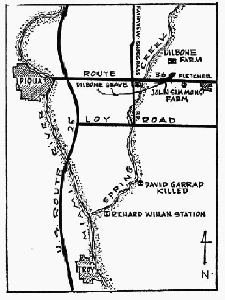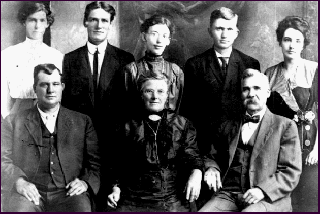It promised to be another hot day. As first
light broke through his cabin window, Henry Dilbone decided today he and his wife Barbara
would harvest in the flax field. He prided himself in being an excellent spinner. From the flax Dilbone would make the clothes his
family would need for the coming winter. The date was August 18, 1813.
In those times, a neighbor was a precious
commodity. When Dilbone and his family moved to Springcreek Township, Miami County, Ohio
in about 1806, there was only one other settler in the entire township. Over the next
seven years, George and John Caven, Benjamin Winans and William McKinney also purchased
land nearby.
When the War of 1812 ended, an uneasy peace settled over west
central Ohio. Over 6,000 Indians had settled near Indian agent Col. John Johnston's house, northwest of
present day Piqua. Although most were peaceful, there were some troublemakers. Chief among
them were two Shawnees: Tecumseh and his brother,
who was known as the Prophet. Reminding those
brethren camped near Johnston's farm that a white scalp was still worth a princely sum
from the British, Tecumseh openly encouraged attacks on the white settlers.
Violence was no stranger to the Dilbone family. When Henry was less than a year old,
the family lived in Pennsylvania. In 1786, his father, John, sold the family farm. Shortly
afterward, he left on a trip to Baltimore with his life savings. When he did not return as
expected, friends set out to search for him. They found twenty-six year old John Dilbone
shot dead, robbed of his money. Henry grew up never knowing his father. He was determined
to move to the Ohio Valley, buy some land, and control his own destiny. After marrying
Barbara Millhouse in 1805, they moved to northern Miami County the next year.
As the sun rose on that fateful
morning of August 18, Henry Dilbone had every right to be proud of what he had
accomplished. After once defaulting on his payments and having to give his land back to
the government, he worked for others for a time, and eventually re-entered the land. By
1813, he owned and had paid for 180 acres. The Dilbones had four beautiful children. They
occupied a cabin on the east bank of Spring Creek, just south of Snyder Road.
Besides being called on by the
neighbors, the Dilbones received visits from Indians who would often trade deer and turkey
meat for bread. Henry enjoyed the visits but he would not hesitate to express his opinions
about Tecumseh and the others who advocated violence. Apparently word about this filtered
back to Mingo George, a Shawnee generally regarded as one of the troublemakers. As
Mr. and Mrs. Dilbone left for the flax patch that afternoon, their eldest son, John, was
left to care for the other children. The dreadful events that next occurred were recalled
years later by John Dilbone in an interview by Albert Cory of Sidney's Valley Sentinel newspaper.
As Henry worked in the flax
field, the children settled down to play under the shade of a black walnut tree. Suddenly,
a shot rang out. Henry slumped to the ground. Mrs. Dilbone immediately ran toward her
children, but the Indian swiftly overtook her. With one smooth swing of his tomahawk, he
split her head open. In the presence of her horrified children, he proceeded to scalp her.
The Indian then walked slowly toward the trembling children.
Young John
Dilbone heard the report of another gun some distance to the south. Although he did not
know it at the time, the gunshot was part of a coordinated attack. Other Indians had just shot and killed David
Garrard, one of Dilbone's neighbors four miles to the south. John slowly turned to face
the advancing Indian. Apparently fearful that help was on its way, the murderer turned and
began running away.
William McKinney heard the shooting and arrived quickly. Henry Dilbone was
still alive, having been shot through the chest. Dilbone was taken to a blockhouse near
Piqua. He clung desperately to life. Two days later, Henry asked to see the body of his
wife. Shortly after his grieving neighbors complied with the request, Henry died. He was
just 27 years old. Their bodies were secretly buried one and a half miles due west of
where Fletcher, Ohio is now located.
A party of settlers set out to find the murderers. Mingo George and his
cohort escaped and traveled north into Shelby County. They stopped for dinner the next day
at the Robert McClure cabin, which was located north of what is now Houston. Only 16 year old
Rosanna was home.

A reproduction of a 1948-1970 Scrapbook
from Newspaper Articles on Local and Regional History.
Written and compiled by Leonard U.
Hill, prominent Piqua historian.
Unaware of the
Dilbone tragedy, she fed the Indians and sent them on their way. The Indians were
fortunate. Rosanna had the reputation as an excellent marksman, having killed a panther, 6
wolves, 22 raccoons and 2 deer in one winter.
Frontier justice was not long in coming.
Gardner Bobo, formerly a militia captain in the Revolutionary War and a friend of the
Dilbone family, secured the services of William Richardson. Richardson was happy to help
as he was the brother in law of Barbara Dilbone. Together they lay in wait for Mingo
George where the present Miami-Shelby county line crosses the Miami River. He appeared at
dusk as he was returning from the grist mill on the Miami River. They shot the Indian and
punched his body into a quagmire near the river bank with a long pole.
Peace returned to the area. Heart
broken neighbors raised the Dilbone children. Priscilla died at age 13. Margaret married
Samuel Lindsay, Jr. and lived nearby. John lived to an old age, and eventually owned most
of the family farm again. William also made a living as a farmer. He subsequently moved to
Shelby County and owned land in Perry Township.
When workers were paving the old
Piqua-Urbana Road in 1918 (now U.S. route 36), they uncovered human bones one and a half
miles west of Fletcher. Cory Henman, a descendant of the Dilbones, was called to the scene
to verify the location. A memorial was erected there in December of 1949 to commemorate
the final resting place for the victims of the last Indian massacre in Western Ohio. At
the dedication, local historian Leonard U. Hill closed the ceremony with the following
words: "May all who view this marker be reminded that: the present day comforts of
life, the ease of acquiring a living and our assurance of security were not always thus.
All of our pioneering ancestors endured many great hardships and a few, as the Dilbones,
made the supreme sacrifice."The
author wishes to thank the Dilbone family for the research materials and the photograph
they provided for use in the preparation of this article.

Front Row: Elba Sylvanus Dilbone, Sarah Catherine (Sally) Covault, Wife of David,
David Benjamin Dilbone.
Back Row: Anna Etta Benschoter, Wife of Elba, Clyde Marion Dilbone, Mary Kepler, Wife of Clyde,
Cleon Pryon,
Husband of Ocie,Ocie Dilbone. Elba, David and Ocie are children of David and Sally Covault .
[ Back to Indians Index ] |

